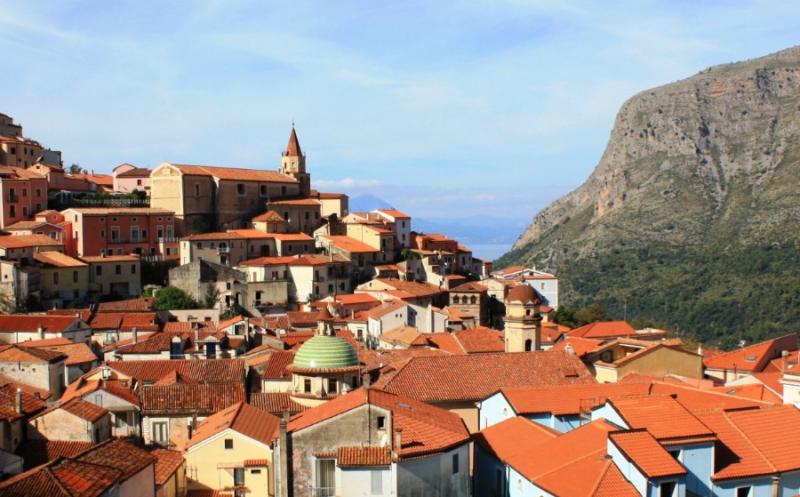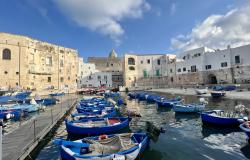After the roasting drive from Naples some 200 kilometres to the north, the prospect of the glistening turquoise waters of the Gulf of Policastro is indeed a welcome sight. This is the first glimpse of Basilicata’s short but beautiful 30 kilometre Tyrrhenian coastline. What it lacks in length is more than made up for by its dramatic beauty as the thickly wooded rocky slopes of the Lucania Apennine mountains greet the crystal clear waters. The chief town of Basilicata’s coast is Maratea, a most agreeable settlement, no longer exactly undiscovered, but still relatively uncrowded. It is well-equipped to offer visitors an attractive and unspoilt base for exploring the coastline or to make the occasional excursion into the hot interior of Basilicata – possibly to see the ancient Roman site at Grumento or the beautiful Parco Nazionale del Pollino. If you want to avoid the hazards of driving out of Naples, a regular train service stops at Maratea on its way down to Reggio Calabria at the very toe of Italy.
Maratea Town
Known as the city of 44 churches – around every corner there seems to be another place to pray. These days they aren’t very busy with worshippers but it is worth visiting at least one or two of their number even if it is just to savour the architecture. San Vito, situated on the edge of town, is the oldest and dates back to 11th and 12th centuries with 15th-century frescoes and a 19th-century campanile. In the centre you will certainly notice the Church of the Annunciation on Via San Pietro, its doorway flanked by a pair of ancient stone lions and an obelisk bearing a statue of San Biagio.
Needless to say there is a lot more to do in the town than visit churches. During the summer Maratea hosts a series of concerts and a folk festival as well as various ballet, theatrical and gastronomic events. However, at any time of year it is a pleasure to just wander around the beautiful unspoilt medieval centre, perhaps stopping to visit some of the numerous craft, clothing and food shops or sample one of the vast range of local limoncello liqueurs on sale in several shops. All this in an atmosphere of friendliness as locals beckon you in to sample their drinks, cheeses, sausages, biscuits, or breads. Stop at the Pasticceria Iannini in Vicoletto Rovita to sample their delicious citrus pastries or chocolate.
Unexpected Surprises
It is not hard to fall into step with the unhurried way of life that most locals seem to enjoy, especially as the summer temperatures start to climb. From Piazza Buraglia at the foot of the town centre walk up Via Cavour to Piazzale Santa Maria Maggiore, named after the principal church in town, a building started in the13th century and developed continuously afterwards. From here narrow streets, alleyways and steps climb up into the heart of the compact old town where you can wander and sample the unexpected surprises. Peeling paintwork to delight the artist, shrines hewn out of the cliff face to halt the pious, cheeses drying in the warm air to cheer the foodie, a sad magpie in a brass cage on a balcony to anger the birdlover. The local tourist office in Piazza del Gesù can give you details of the town and its historic churches and buildings.
Perched above the upper town is La Locanda delle Donne Monache, a former convent with an attractively decorated interior and an excellent restaurant. Its garden, fringed with bougainvillaea and lemon trees, has a swimming pool, a rarity in the old town centre and a peaceful place for guests to cool off. Apart from hosting a range of gourmet evenings and cookery classes, it is always a reliable place to enjoy the excellent local cuisine, especially the seafood and a carefully selected list of Italian wines.
Sanctuaries and Statues
This wasn’t always the main settlement, which was originally centred on Maratea Superiore, the upper town, sited on a rocky outcrop reached by a precarious elevated road which brings you to the Basilica San Biagio. This Basilica or sanctuary, was reputedly built over a pagan temple devoted to Minerva and dates back as far as the 6th and 7th centuries. From here, walk up past the scattered ruins of the original settlement which is believed to have been founded by the Greeks around the 8th century BC. Dominating the skyline is the 22-metre-high statue of the Redeemer which was erected in 1965. Its brilliant white Carrara marble facing contrasts sharply with the usual solid blue sky above and bears a strong resemblance to the great statue of Corcovado, Rio’s popular landmark. The base of the statue commands stunning views north to the Campania coast and south to Calabria especially at the end of the day when the entire coastline is frequently bathed in glorious light. In the clear waters below, major Roman artefacts have been recovered including a processing plant once used to make garum, a fish sauce that was a vital part of Roman cuisine. Every May a colourful procession follows the silver effigy of San Biagio hooded in red cloth as it is carried from the mountain sanctuary down the winding road to the village, where the mayor uncovers it to mark the beginning of a week of celebrations in the saint’s honour. To the outrage of the community, the original 18th-century embossed silver effigy was stolen in 1976.
Along the Coast
However, it is the coast itself that is the main attraction of staying in Maratea. Rocky slopes and outcrops are liberally covered with pines, olives, oaks and carobs, interspersed with wild rosemary, myrtle and broom, and drop away steeply into the clear waters. Scattered along the coast are ancient defensive towers dating back to a time when the coast was prey to the attacks of Saracens and other invaders. The clear sea below offers excellent swimming and snorkelling and has some of the cleanest bathing water in Europe (the municipality has installed a filtration system to keep it this way). The area around Santavenere is particularly attractive and has one of the finest beaches in the area. The five-star Santavenere Hotel and its beachside restaurant, Il Carrubo, makes a sumptuous base from which to enjoy this beautiful location, even if you never stray far from the hotel’s spa or private beach. A more informal way of sampling local dishes is at the Bar Sambacco, also in Santavenere.
Exploring further
Overlooked by the Redeemer’s gaze is the separate settlement of Maratea Inferiore, the small port and a lovely place at all times of day whether in early morning to watch the fishermen or in the afternoon to enjoy a cool drink – try the Antico Caffè del Porto for an evening cocktail. There are numerous caves in the cliffs above the marina and you can also take boat trips from here to explore the caves and grottoes that abound along the neighbouring coastline. You can also hire boats to explore the caves and otherwise inaccessible beaches, to fish or to snorkel.
If you have time to explore the area, the coast to the north is also well worth a visit and Acquafredda offers a particularly attractive beach as well as good fishing. A short detour inland brings you to the beautiful town of Rivello perched high on a ridge and framed by the southern Apennines. Steeped in history, it is a centre for art and craft and has long been known for its exquisite working of copper and gold. It is also a gastronomic centre and has a growing Slow Food movement.








